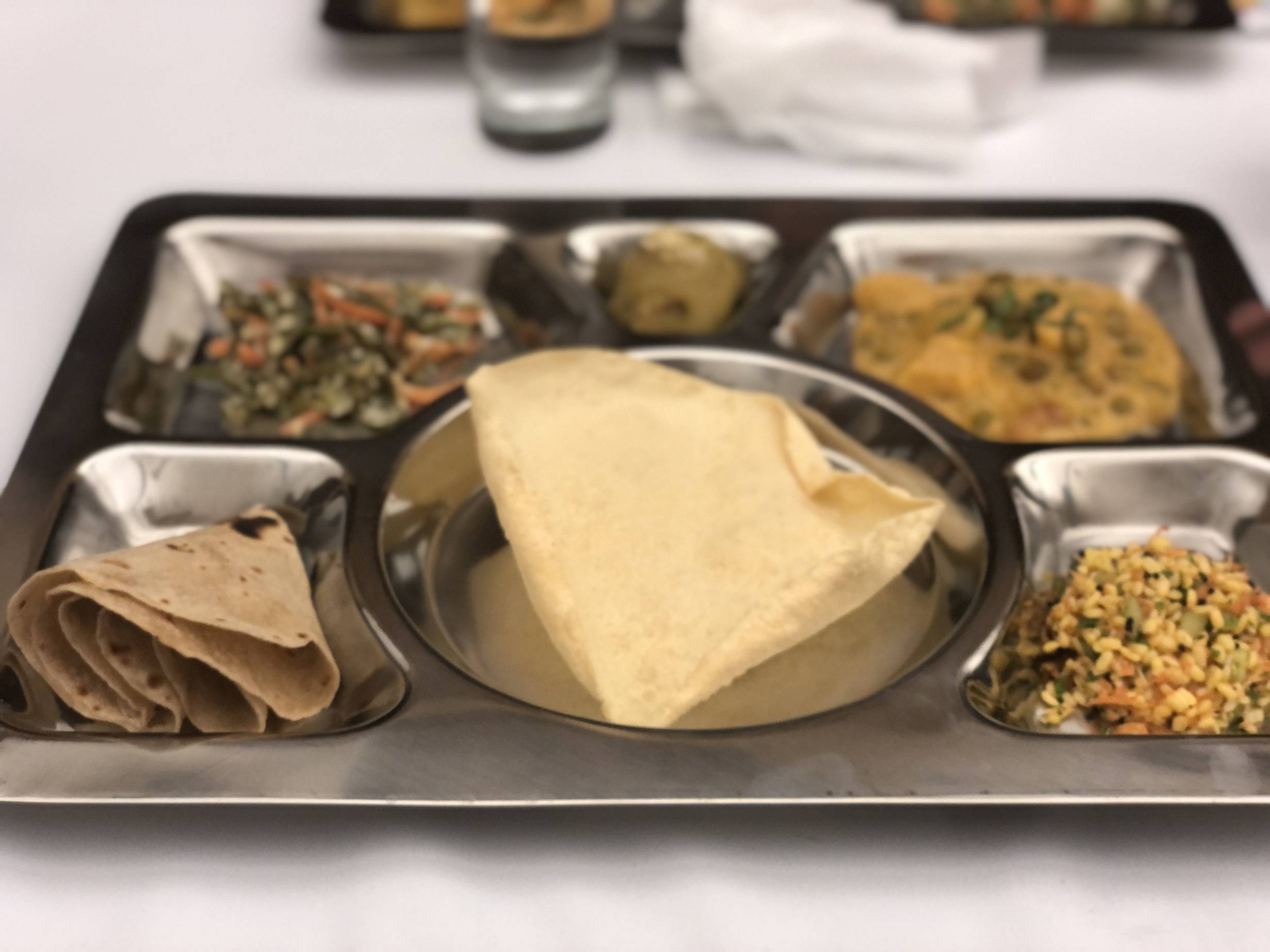More than six courses of Indian food, this event at Japan House gave guests a taste of culture and stories from both Archana Shekara’s childhood in India and her development of recipes while living in the United States.
This past Friday night, I attended the “Ananda, Ultimate Bliss: Indian Home Cooking & Traditions” event hosted at Japan House.
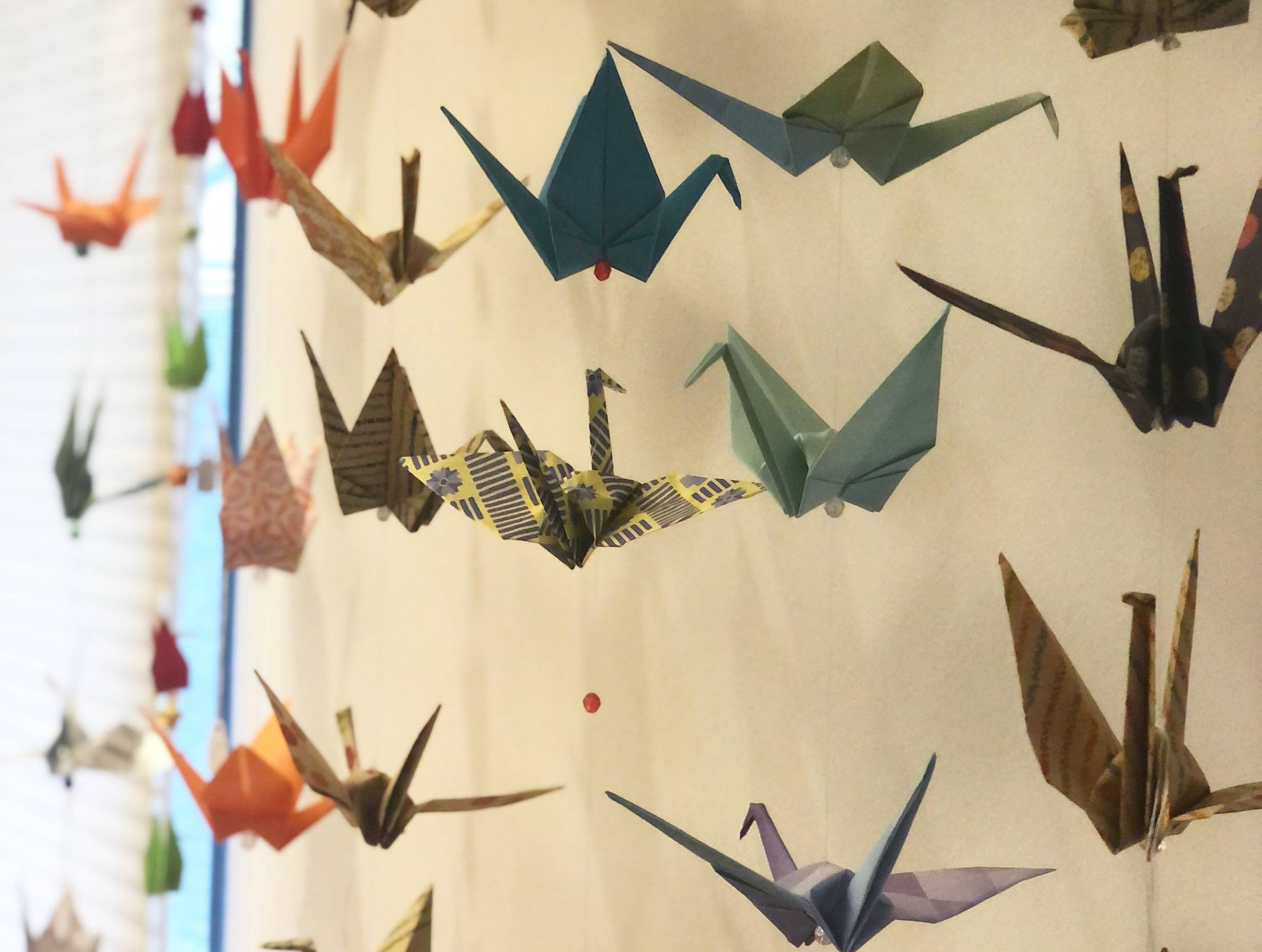
Japan House. Photo by Alyssa Buckley.
Upon entering Japan House, I was welcomed by the charming Michael Darin, Japan House’s Education Experience Coordinator — or as he introduced himself later, the Excitement Coordinator. Guests removed their shoes and put on the provided slippers. It was a lovely touch to help guests like me prepare to have a special experience.
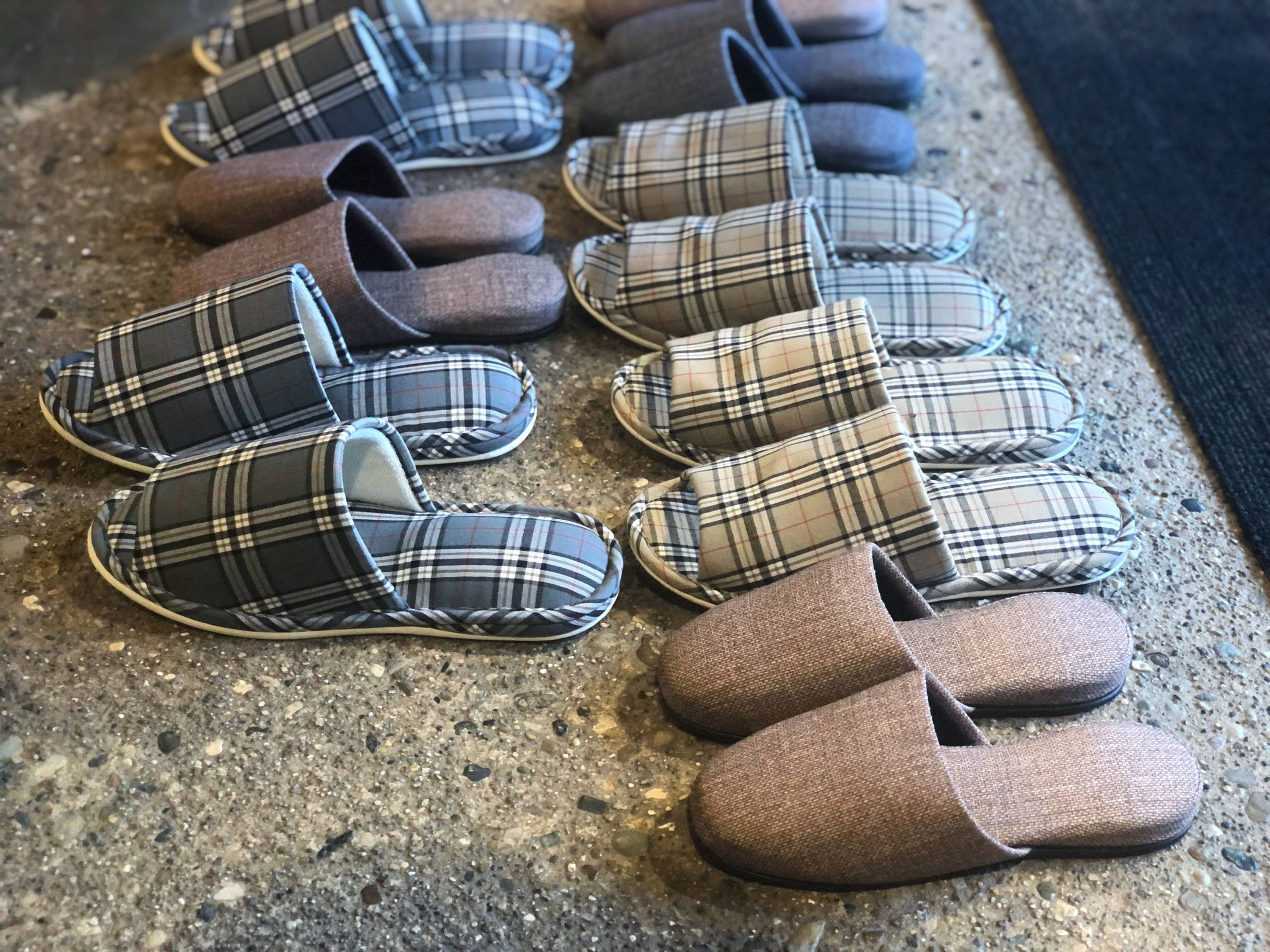
Slippers at Japan House. Photo by Alyssa Buckley.
Japan House Director Jennifer Gunji-Ballsrud welcomed all 24 guests to this event. She shared her desire to share culture, not just the image of culture, but an immersion of culture. She believes that by immersing ourselves in other cultures, we can develop a sensitivity to our culture — and to everyone else’s as well.
Archana Shekara, Associate Professor at Illinois State University, led this participatory, experiential event. Her mother had arrived from India the previous night, and together, Shekara, her mother, and her daughter prepared food all day for this event. The three generations of women stood before the group, and all the guests applauded.
Shekara named this event Ananda which means “ultimate bliss” in Sanskrit. She told us that we would experience ananda, or ultimate bliss, when we ate her food and the smiles on our faces while eating her food would be her ananda.
The evening was set to have six courses: a collection of dishes that Shekara cooks for her family regularly, each described on a beautiful menu. There was no silverware on the table, just a wet towelette for each guest. We were all to eat with our hand. Not hands — just our right hand.
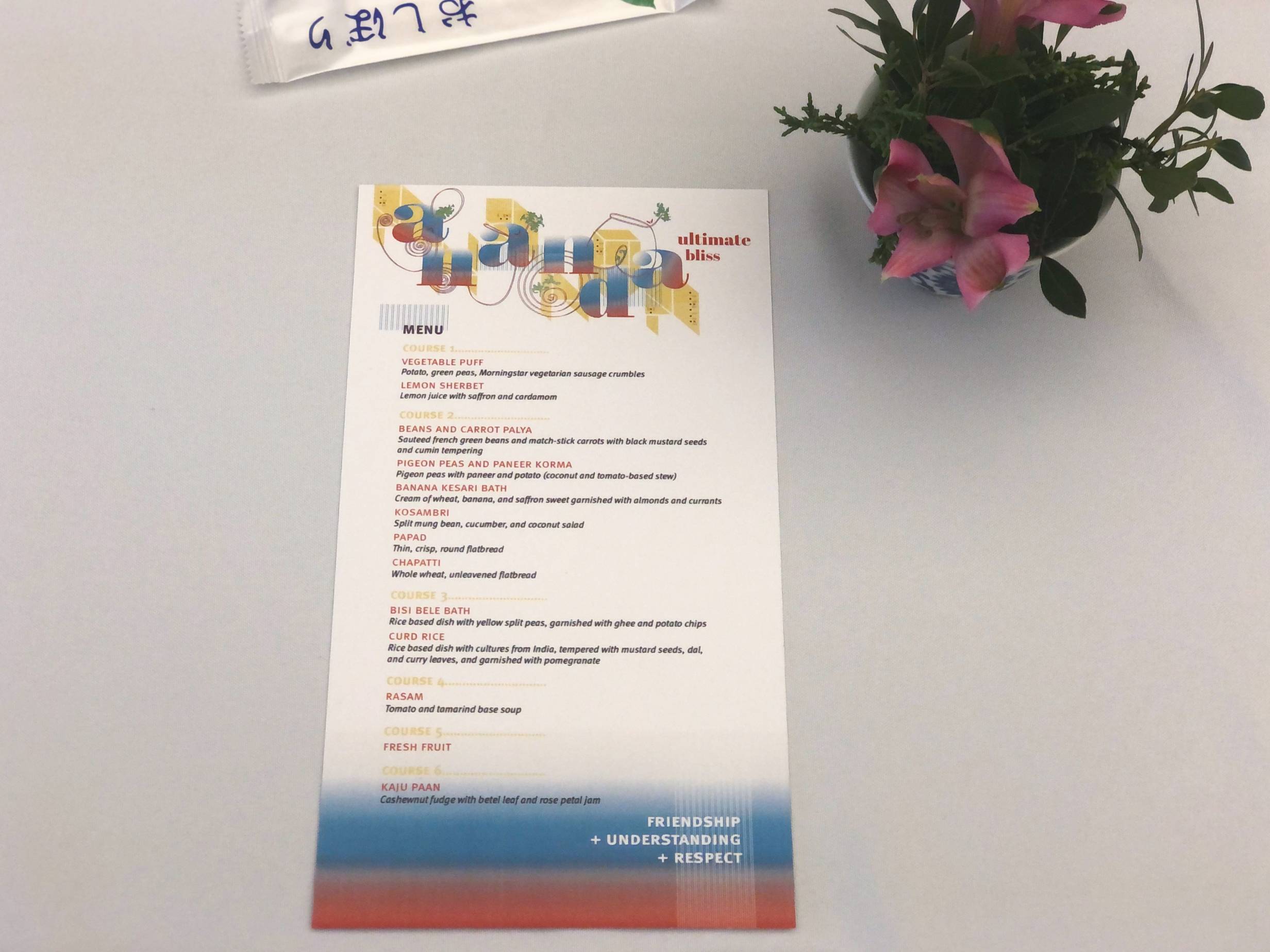
The event menu. Photo by Alyssa Buckley.
I was a bit apprehensive about using my hand to eat. I’d never eaten with my hands before (apart from the usual finger foods), but I was excited to try.
The first course was Lemon Sherbet and Vegetable Puff.
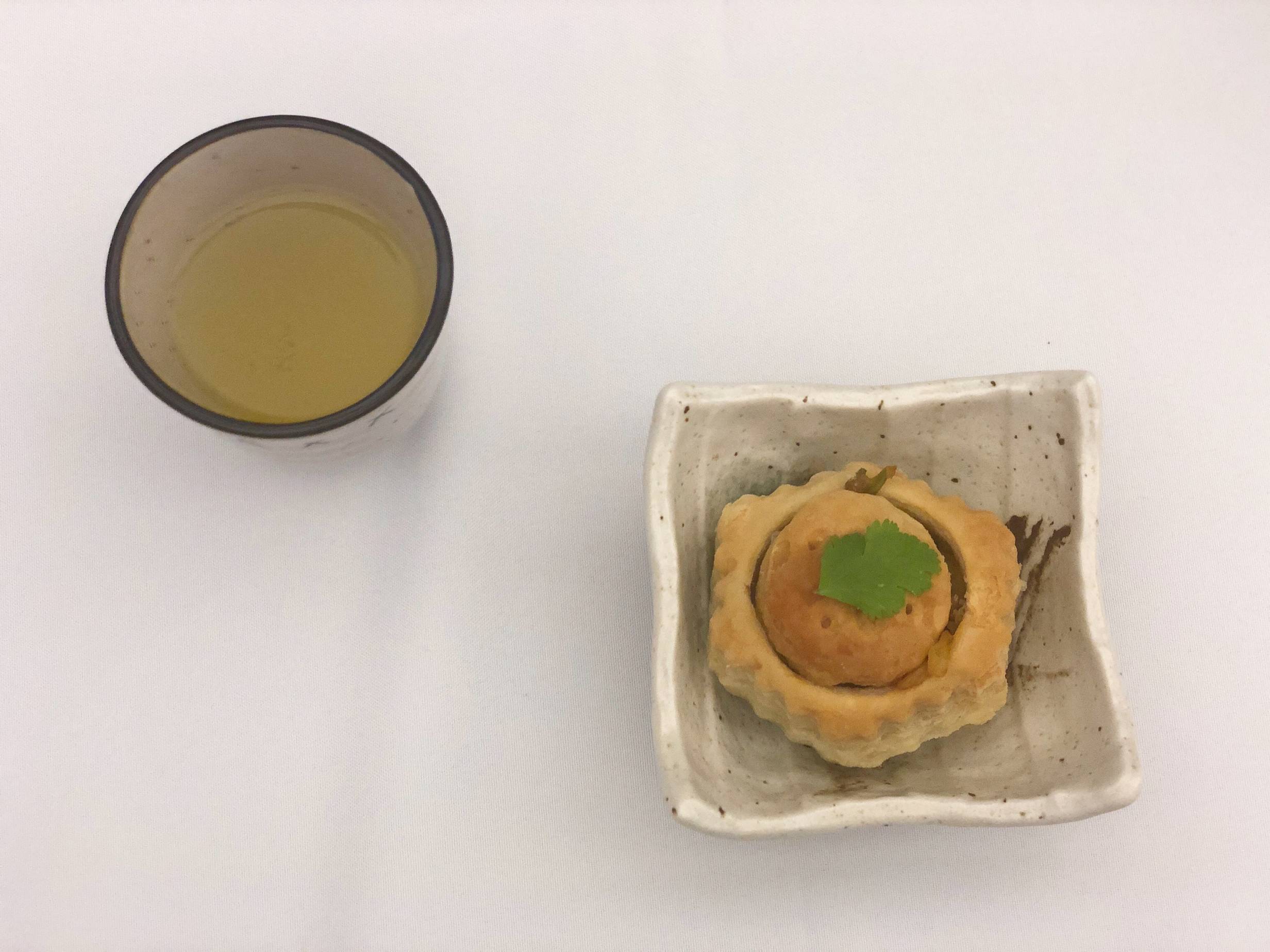
Course 1. Photo by Alyssa Buckley.
Shekara explained that when she was a child, she would go to visit her grandmother. It was so hot outside, and her grandmother would serve her this cold, refreshing drink that her grandmother called lemon sherbet. Later, when Shekara came to the United States, she saw sherbet in the grocery. She wondered why it was in the freezer, and why it was not a liquid?
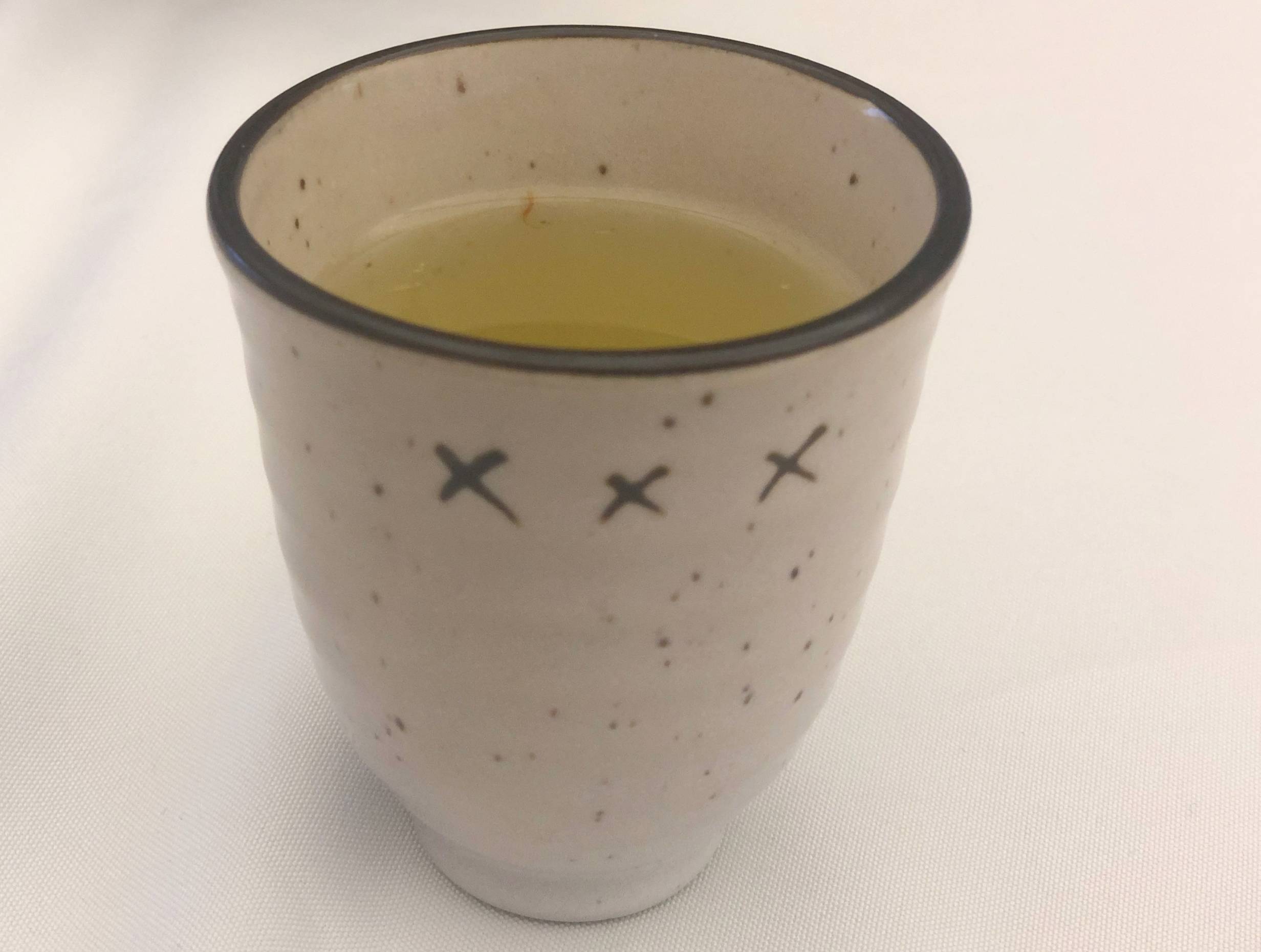
Lemon sherbet. Photo by Alyssa Buckley.
This little cup of lemon “sherbet” was very much like lemonade — though it had so much flavor. It was her grandmother’s recipe of lemon juice, saffron, cardamom, and sugar. It was light, sweet, and aromatic. When I saw the ceramic cup, I assumed it was a warm drink, but this was very cold. The last sip was so flavorful as all the spices had sunk to the bottom. It was so good that I may be inspired to add saffron and cardamom to my lemonade this summer.
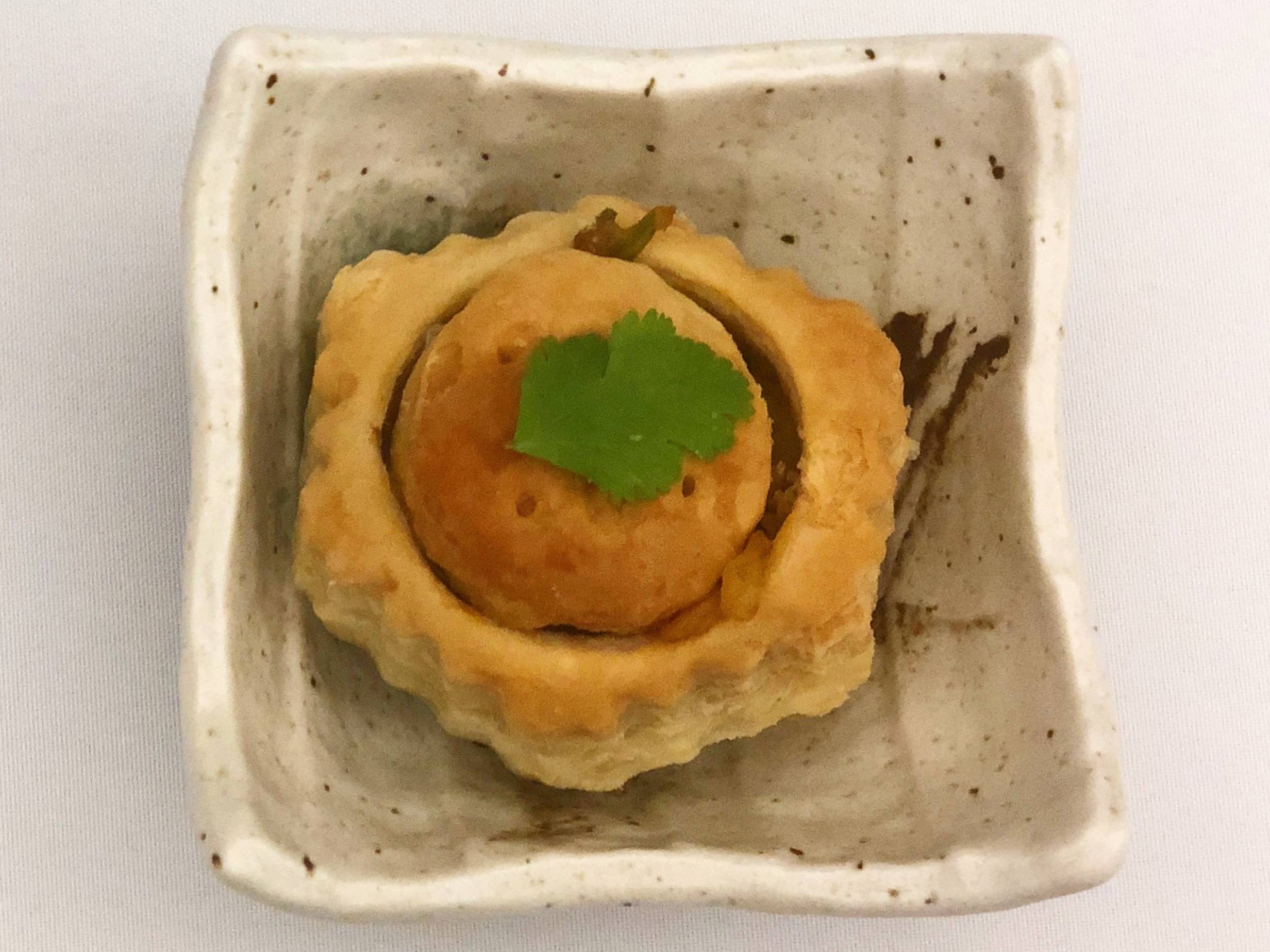
Vegetable puff. Photo by Alyssa Buckley.
The vegetable puff was a puff pastry with potato, green peas, vegetarian sausage crumbles, and authentic spices. Shekara talked about how this dish is an example of colonialism for her in that potatoes, peas, and Morningstar vegetarian sausage are not traditional Indian fillings — very American additions to her authentic spices and recipes from home.
This vegetable puff was incredible. It reminded me of a pot pie with the flaky pastry biscuit and the warm, savory middle. The center was filled with soft potatoes, bright green peas, vegetarian sausage (that, even as an omnivore, I could not tell was vegetarian), and warm orange spices. The puff was a fragile dish to eat with my hand, but a perfect beginner’s course since it was not unlike eating a croissant pastry.
The second course was exactly what I was hoping to eat: a full plate of foods of which I’d never heard and never tried. The meal was served on a food tray that Japan House ordered from India just for this dinner. Talk about immersion!
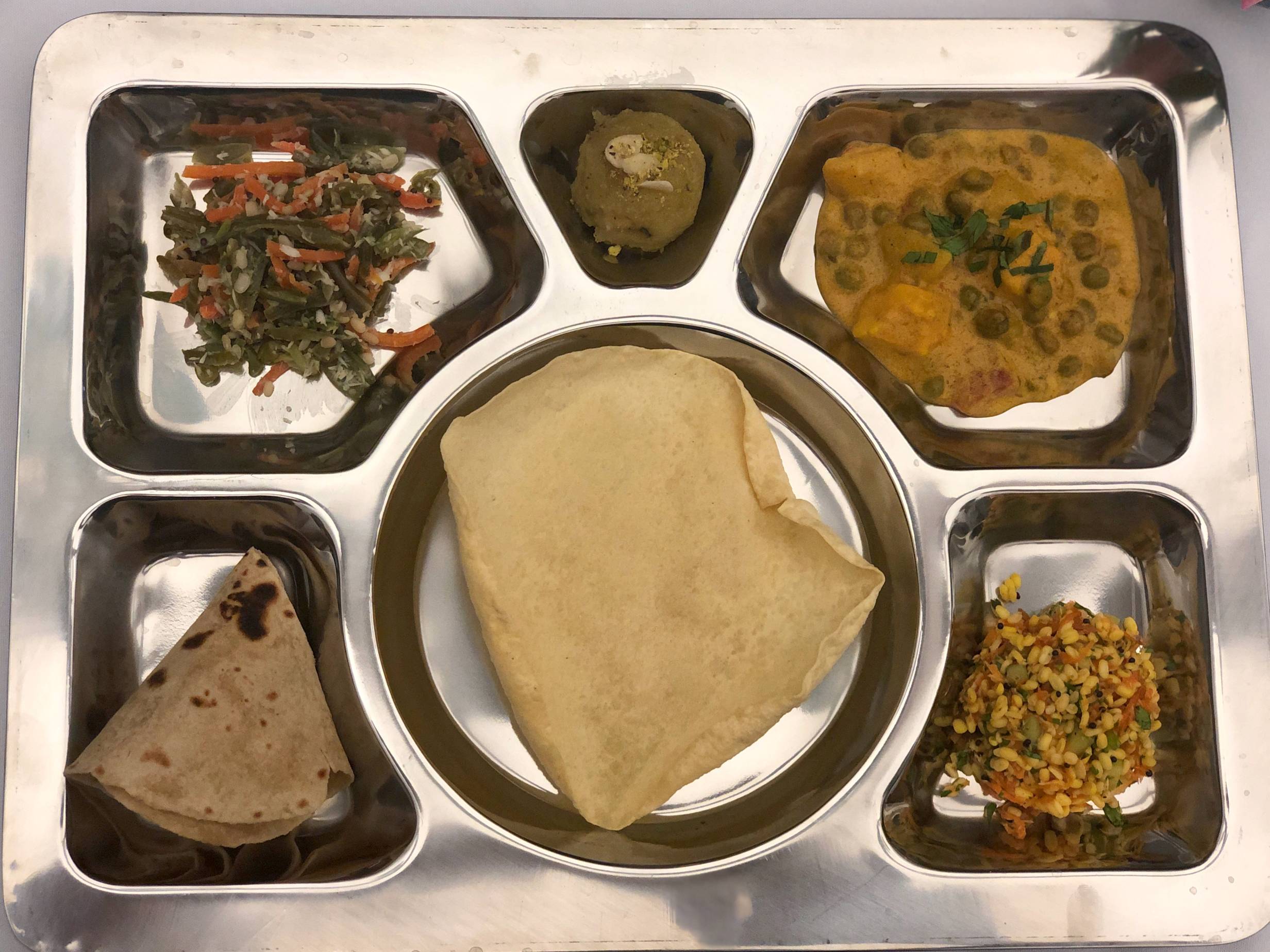
Course 2. Photo by Alyssa Buckley.
Starting with the top left, this metal, bento style plate had beans and carrot palya, banana kesari bath, pigeon peas and paneer korma, kosambri, papad, and chapatti.
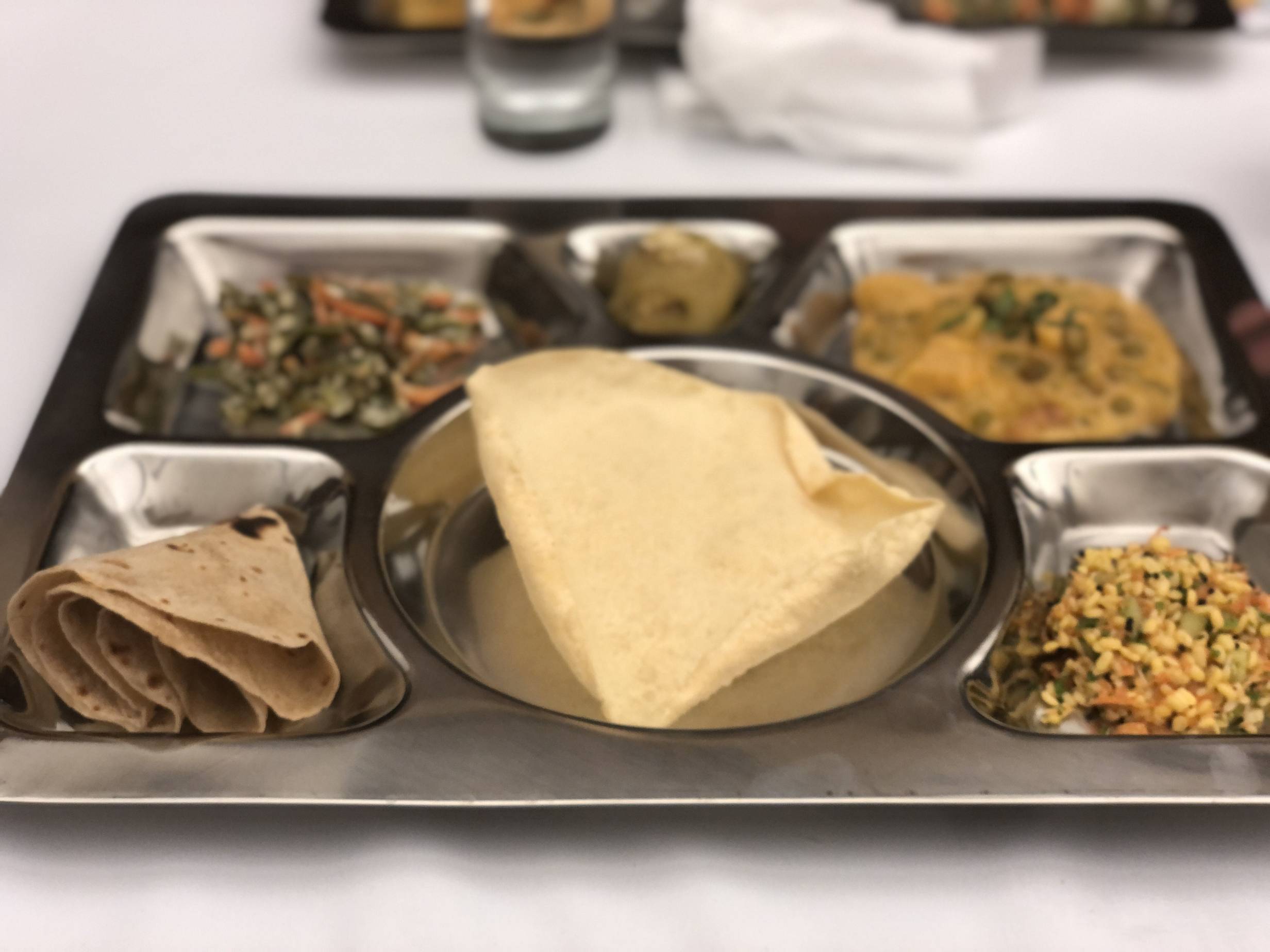
Papad, palya, banana kesari bath, korma, kosambri, and chapatti. Photo by Alyssa Buckley.
Thankfully, Shekara explained to us how to eat this food with our right hand. She demonstrated for us how to tear the chapatti with just one hand and roll it with three fingers. Shekara explained how to use just three fingers and our thumb to gather food. We were told not to let the food fall past our fingertips, that our palms should remain clean.
I ate my dessert first, as instructed by Shekara. Eating dessert first felt wrong, but while I was eating it, I realized that it was just different — and so fun — to begin with the sweet.
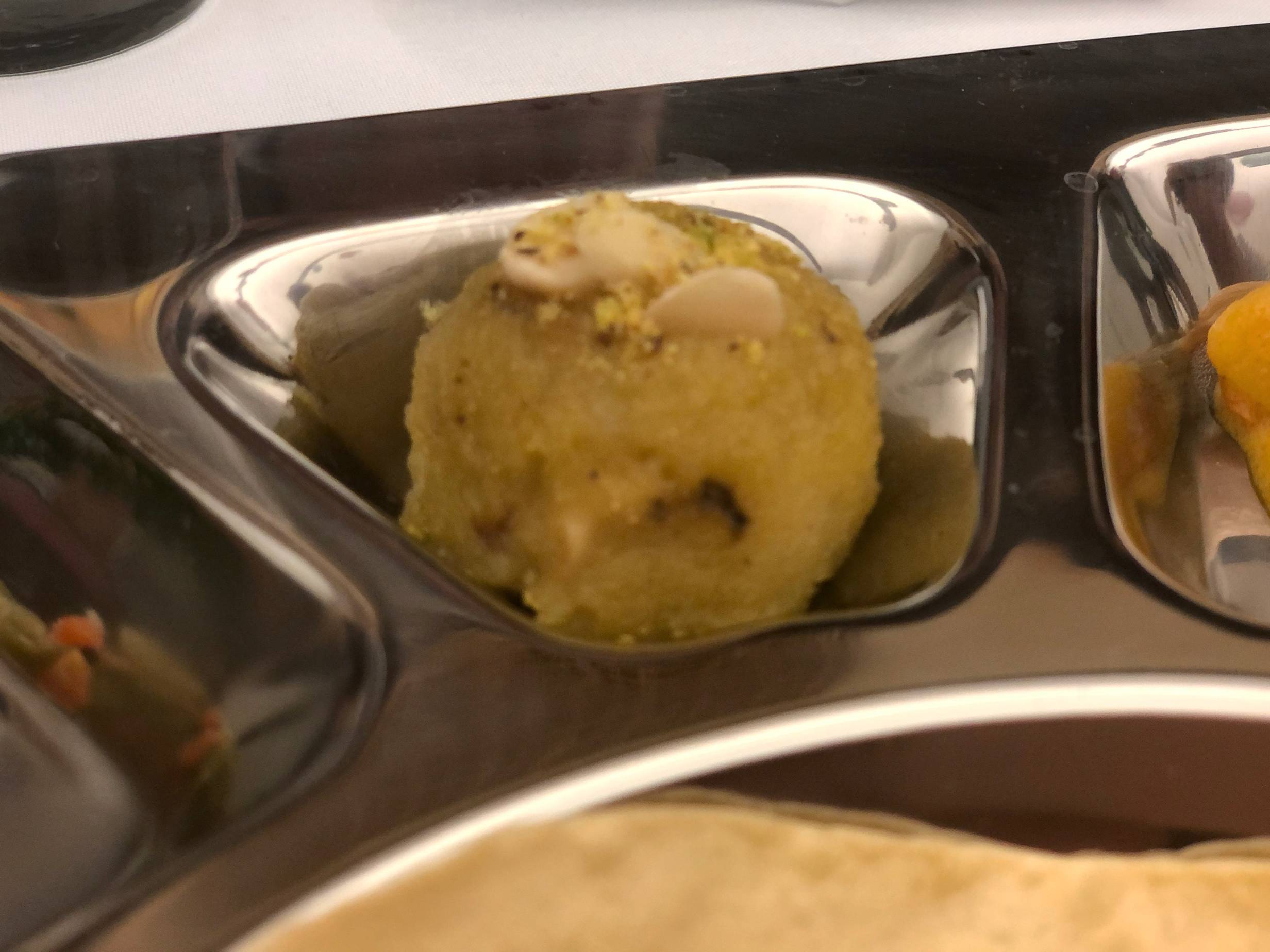
Banana kesari bath. Photo by Alyssa Buckley.
The banana kesari bath was a delicious, soft ball. This sweet was made with cream of wheat, banana, and saffron garnished with almonds and currants. It had a strong almond flavor, and it reminded me of banana bread.
Next, I tried tearing the chapatti (which looked a lot like a tortilla) with my right hand like Shekara demonsrated.
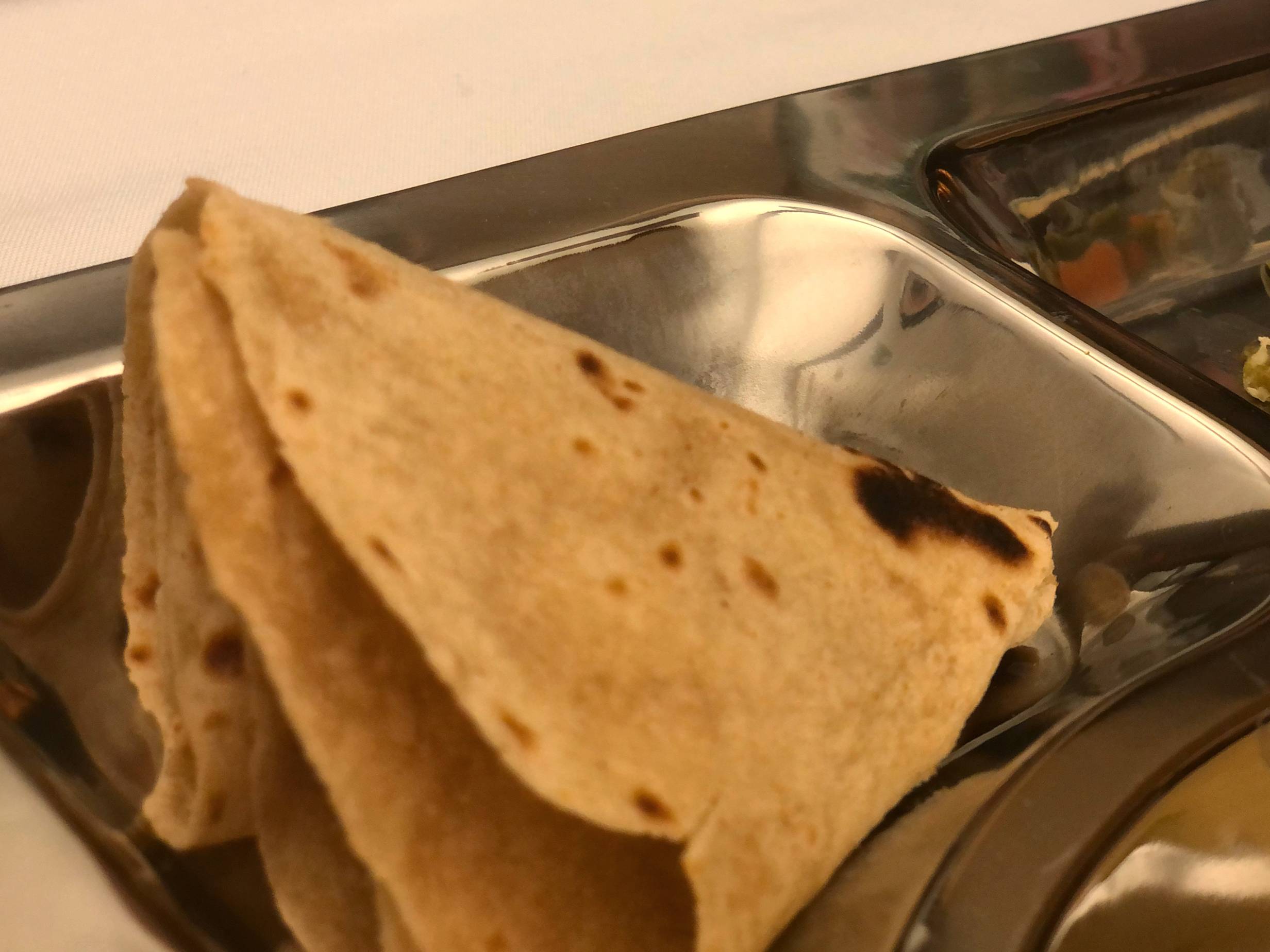
Chapatti. Photo by Alyssa Buckley.
The chapatti was a whole wheat, unleavened flatbread. It was deliciously fresh and easy to tear. The flavor was light. I was able to tear a small piece that I used to scoop some of the beans and carrot palya.
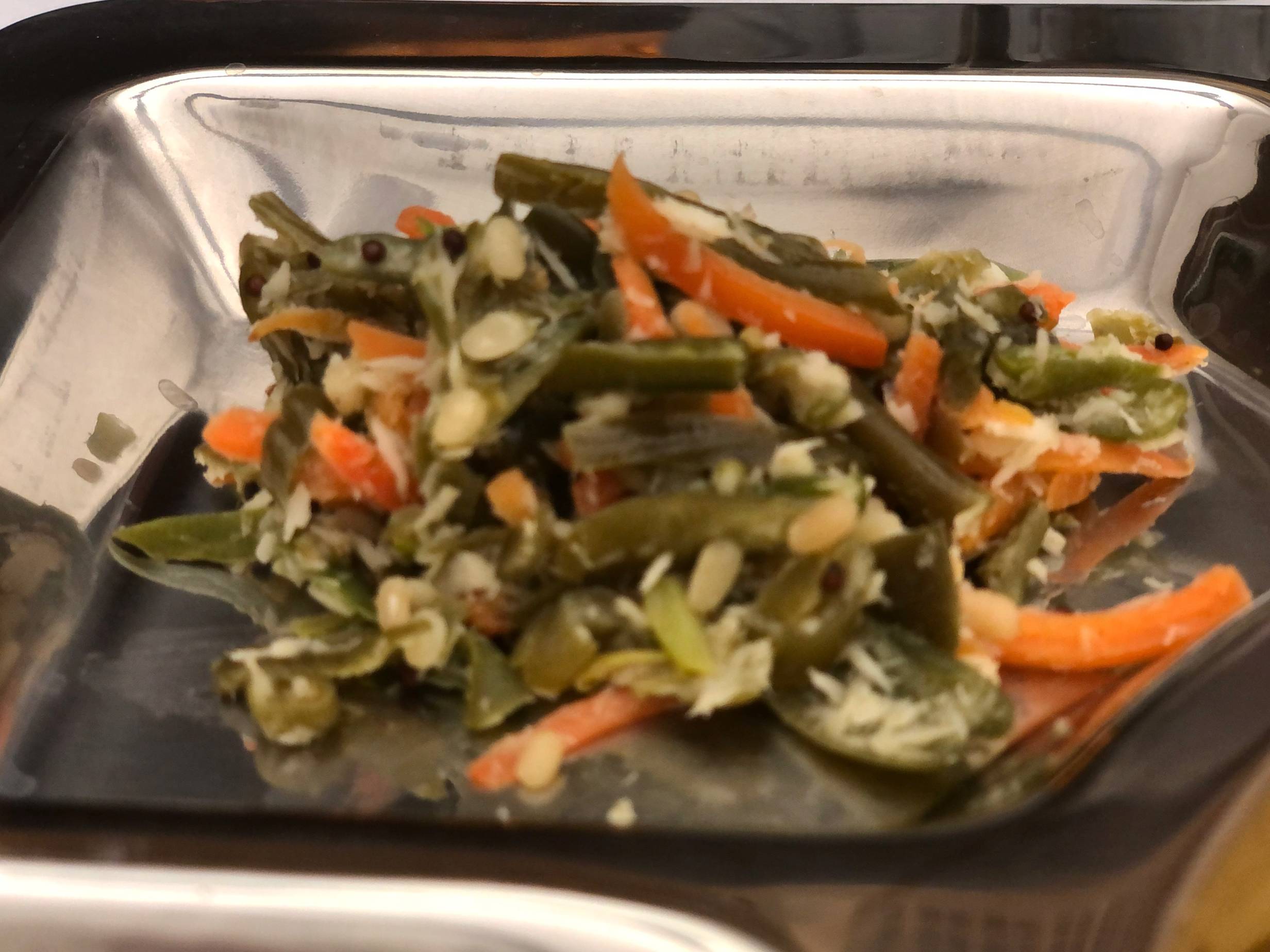
Beans and carrot palya. Photo by Alyssa Buckley.
Palya is the Kannada word for a vegetable dish. Shekara’s palya was made with sauteed french green beans, match-stick carrots with black mustard seeds and cumin tempering. The palya was like a slaw, lightly seasoned and crunchy.
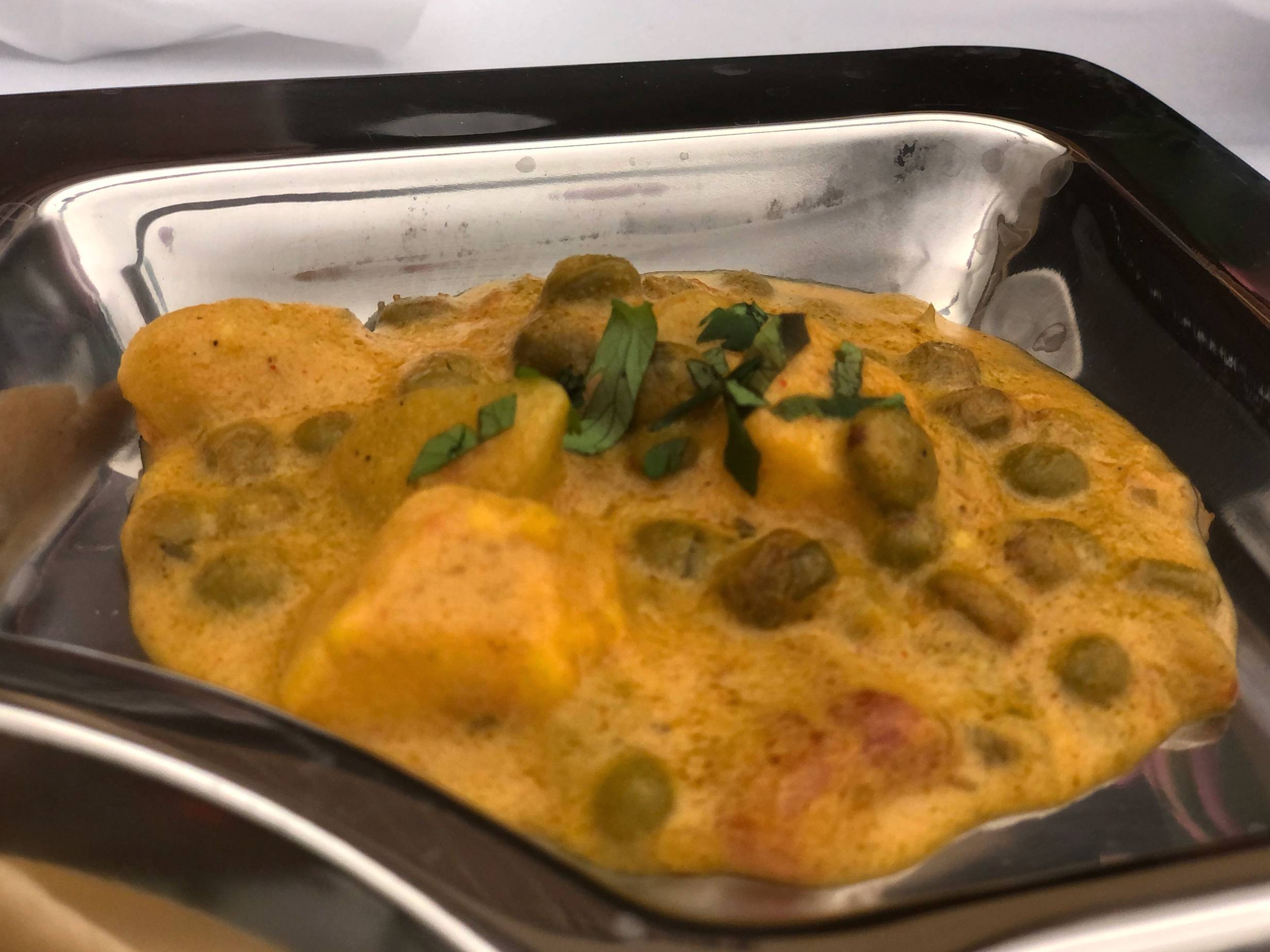
Pigeon peas and paneer korma. Photo by Alyssa Buckley.
I was instructed to try the chapatti with the pigeon peas and paneer korma as well. This is a dish that is from Shekara’s caste. It was a light yellow curry dish that looked a bit like soup. The korma had a thick yellow sauce made from a coconut and tomato based stew and mild seasonings with pigeon peas, paneer, and potato. I’d never had pigeon peas before, but they were delicious. It was difficult to eat with my hand, but I enjoyed the challenge.
As we ate the second course, Shekara spoke to us about how eating with our hand utilizes pressure points in our fingers and makes us salivate. She talked about how it was a sensual experience, and I definitely experienced that. It was a much slower dinner; my hand could not fit as much food as a spoon would, but it was nice to have small bites and let the flavors and textures linger. I experienced the textures of food in new ways — with my fingers first, and then as I ate.

Papad. Photo by Alyssa Buckley.
In the center was papad. This papad was a thin, crisp round flatbread that was made from lentils. Shekara cooked it that evening in a pan with hot oil. She dropped it in the hot pan; it immediately got big. Quickly, two seconds later, she took it out. The papad was paper thin and cracked into pieces easily. It was a delicate crisp like I’d never had before.
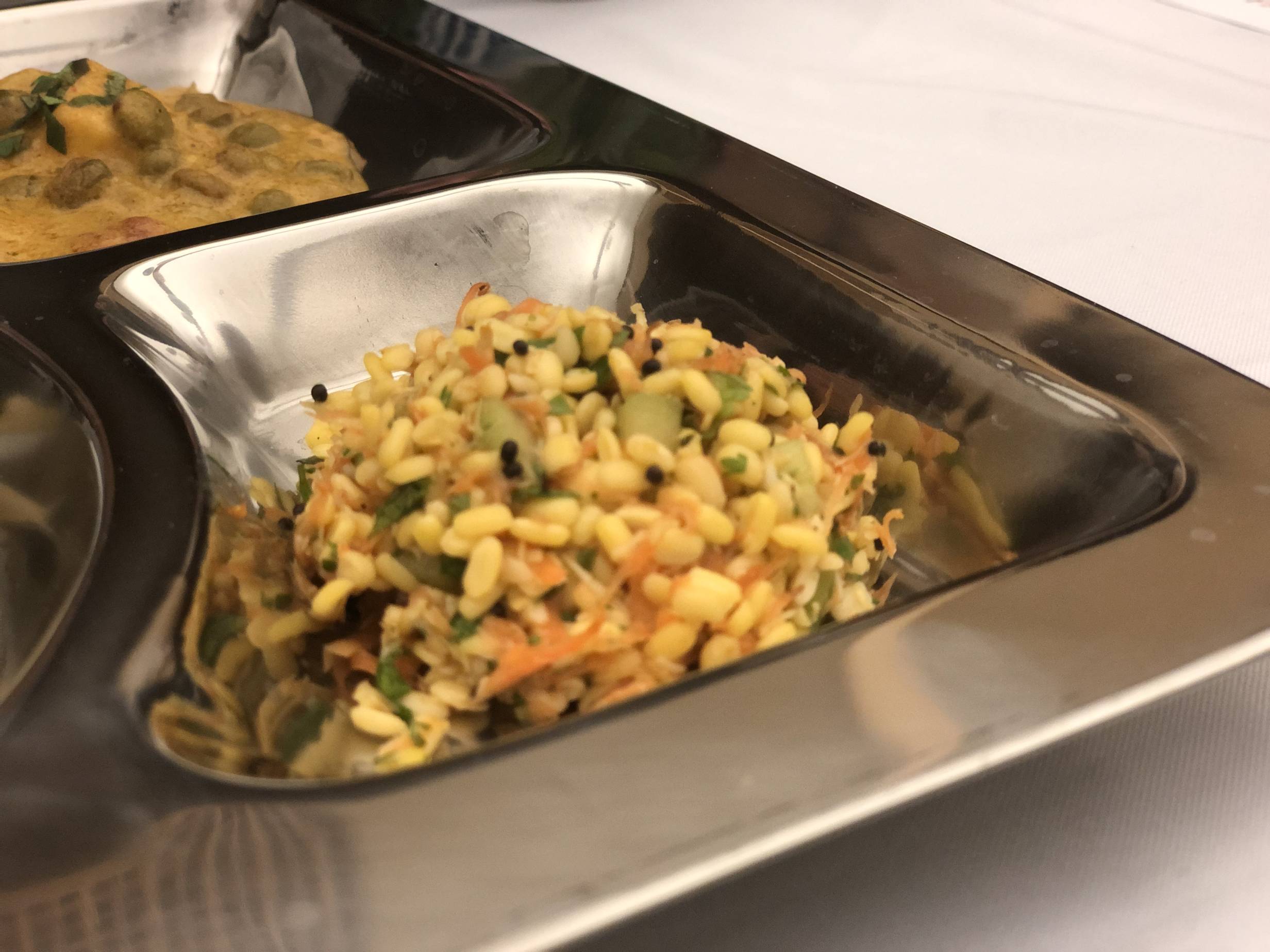
Kosambri. Photo by Alyssa Buckley.
On the bottom right, there was kosambri, a south Indian salad. This kosambri was made with split mung bean, cucumber, and coconut. It was beautiful and fresh tasting with a bit of lemon. I especially thought the varied textures made the salad: smooth beans, thin carrot, and crunchy, cubed cucumber. I enjoyed trying to pick up the tiny mung beans with my fingertips.
It was so delicious that I ate everything from the second course.
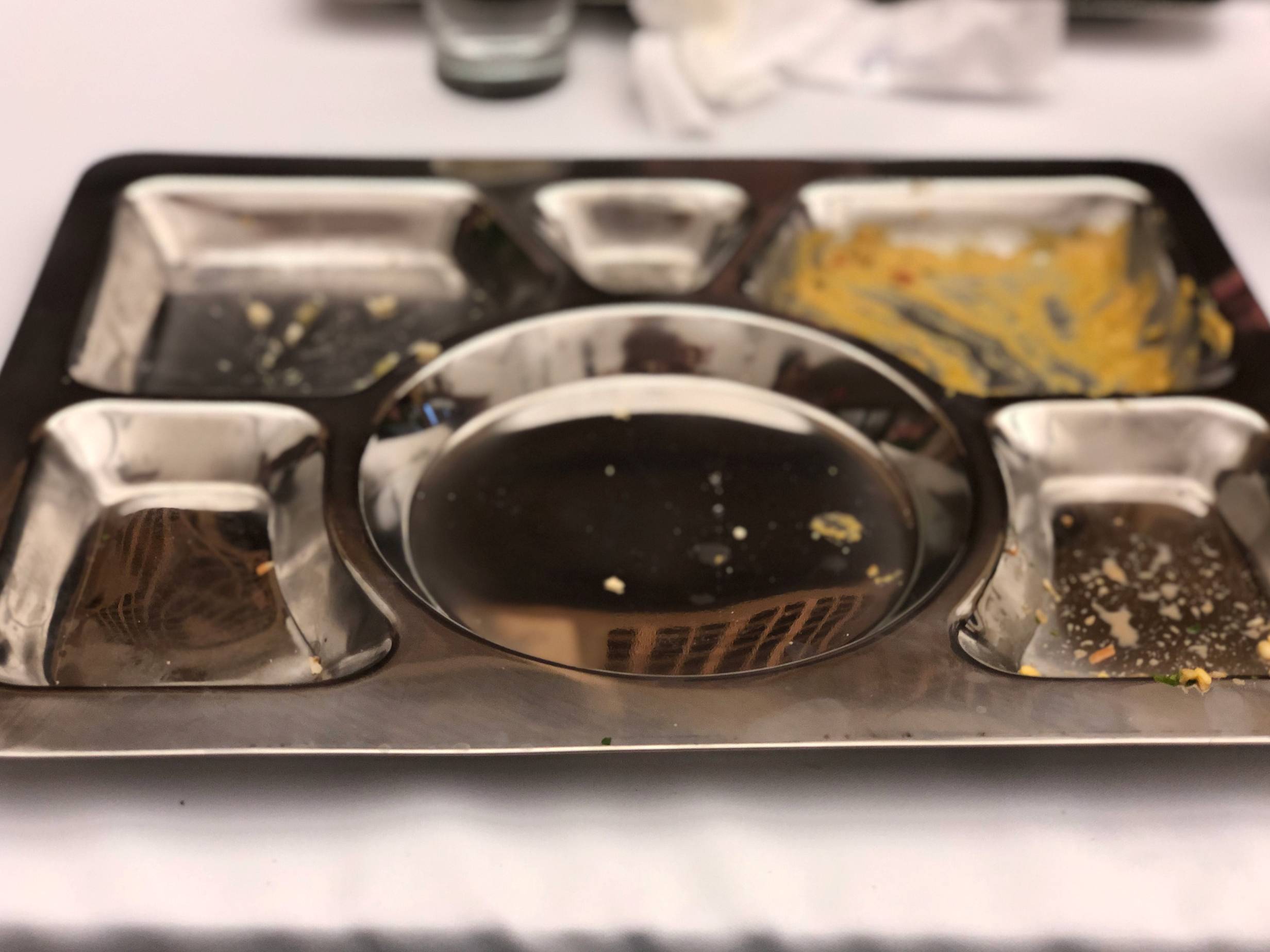
An empty tray. Photo by Alyssa Buckley.
The next course was served on the same metal tray as the second course, so it was a wonderful thing to have finished everything from the previous course. This course was Bisi Bele Bath and Curd Rice.
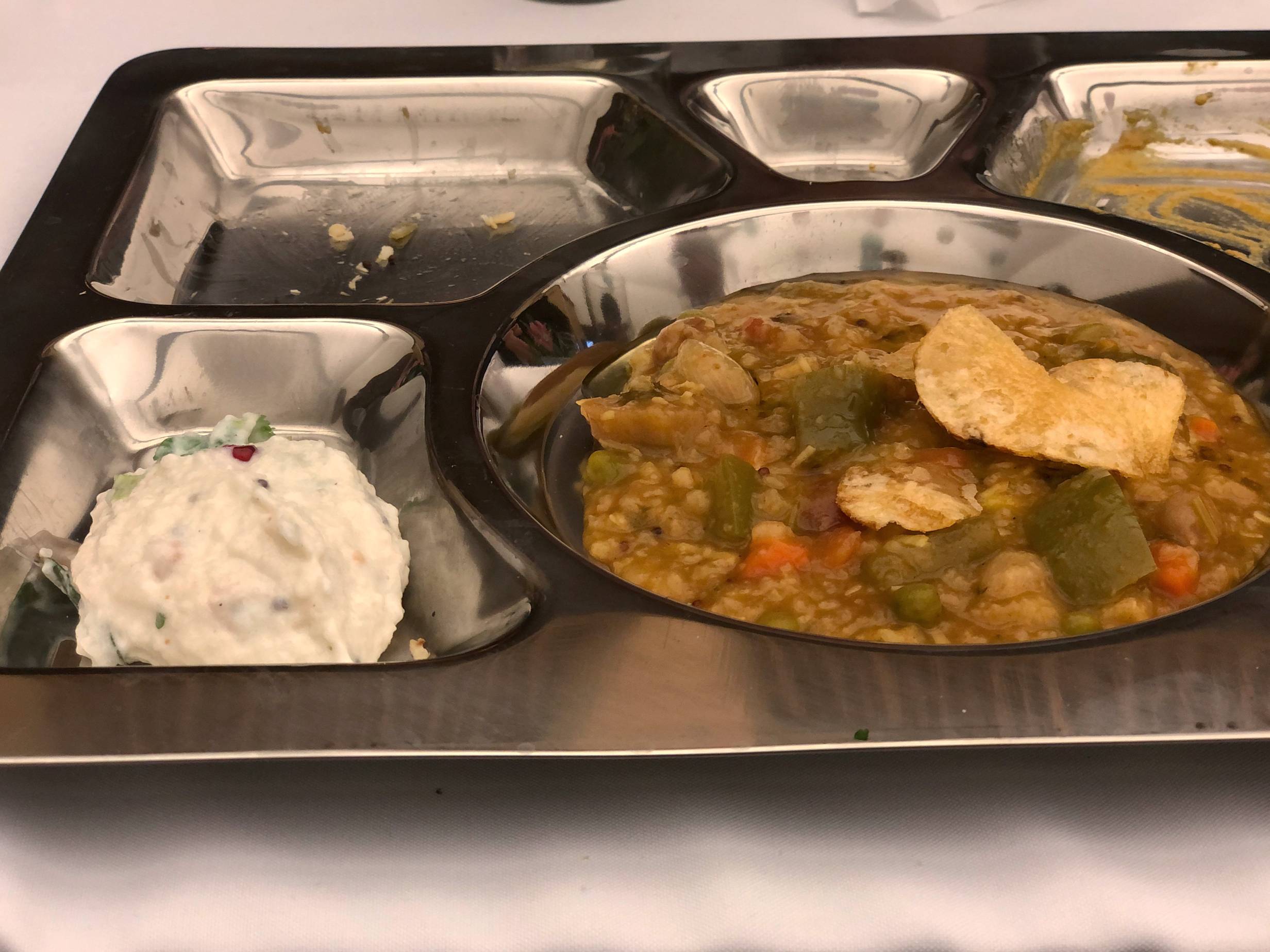
Course 3. Photo by Alyssa Buckley.
Bisi bele bath, or in Kannada “hot lentil rice dish,” is a dish for which Shekara is known; it is that good. Several Japan House interns served each guest tableside for this course.
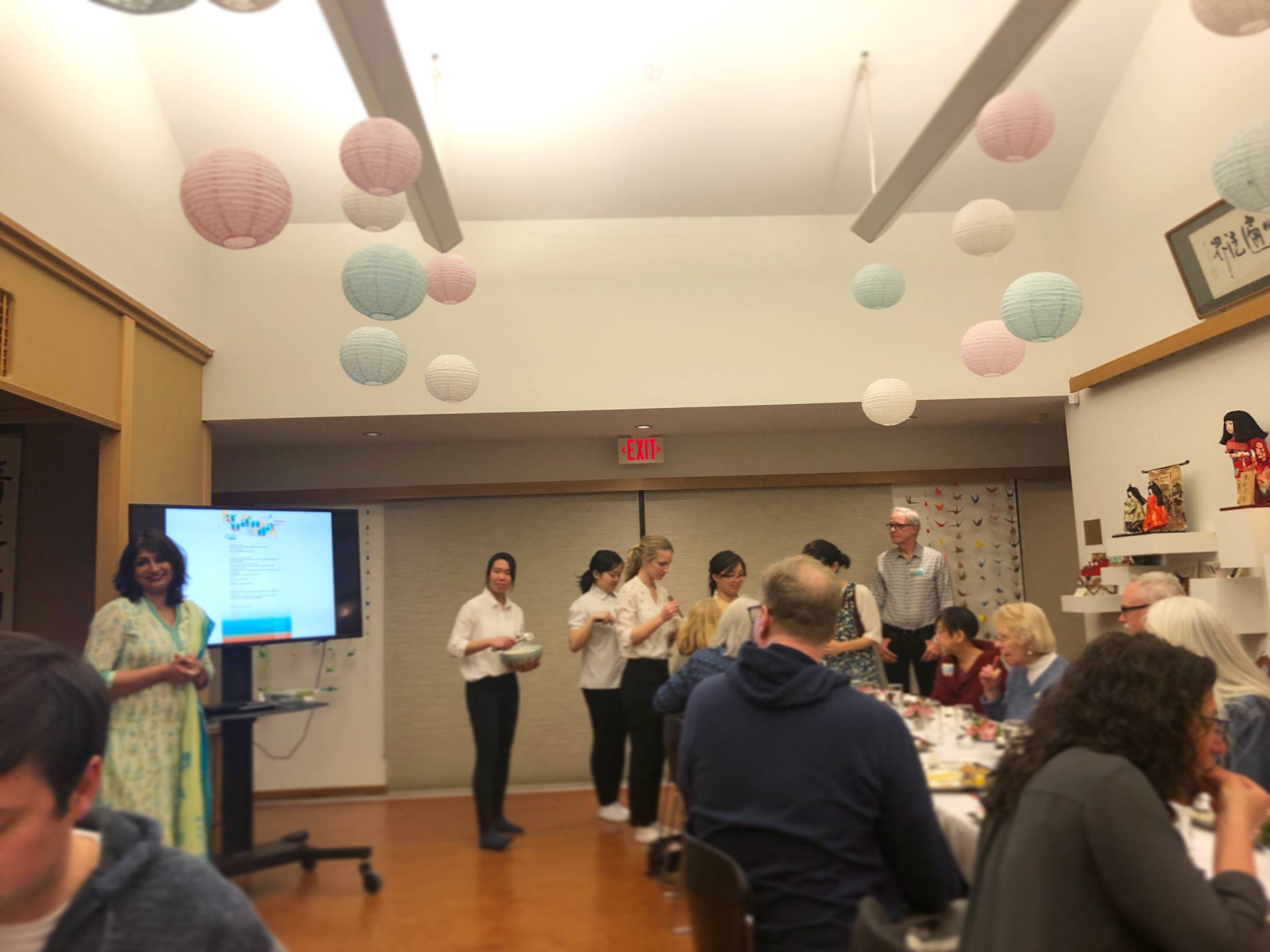
Archana explaning Course 3 with interns serving dinner guests at Japan House. Photo by Alyssa Buckley.
First, the lentil rice dish was scooped into the center. Next, a generous pour of ghee. Last, a few potato chips on top. Shekara told us that the potato chips are not a traditional part of this dish, but this is how her family eats it at their home: a blend of American and Indian cuisine.
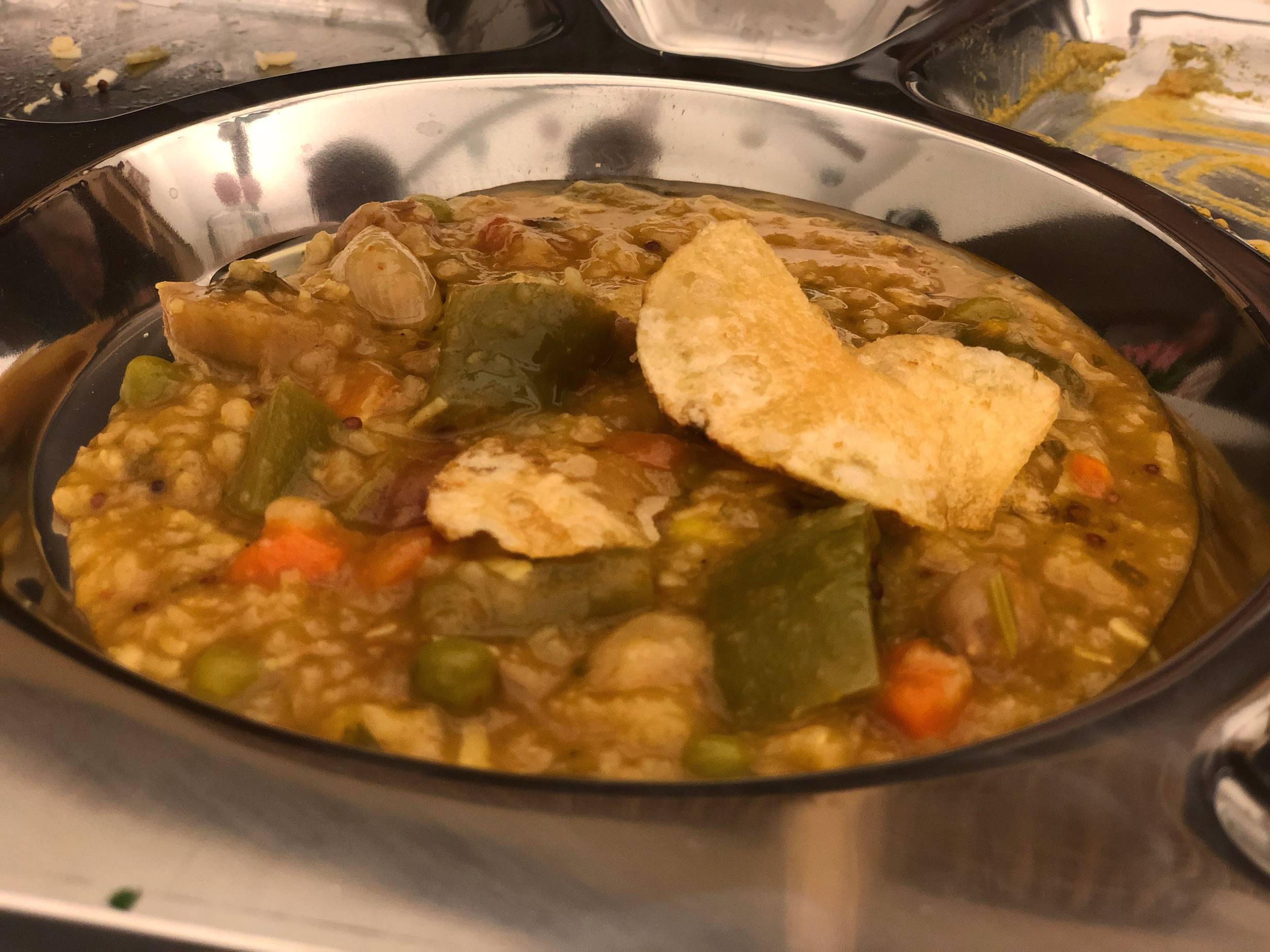
Bisi bele bath. Photo by Alyssa Buckley.
It was a warm, thin dish very much like soup. It was made with rice, pearl onions, green peppers, green beans, carrots, and yellow split peas. The ghee was a decadent addition to an otherwise light dish. The chips were such a contrast to the bisi bele bath, but they provided a helpful tool for scooping the bisi bele bath.
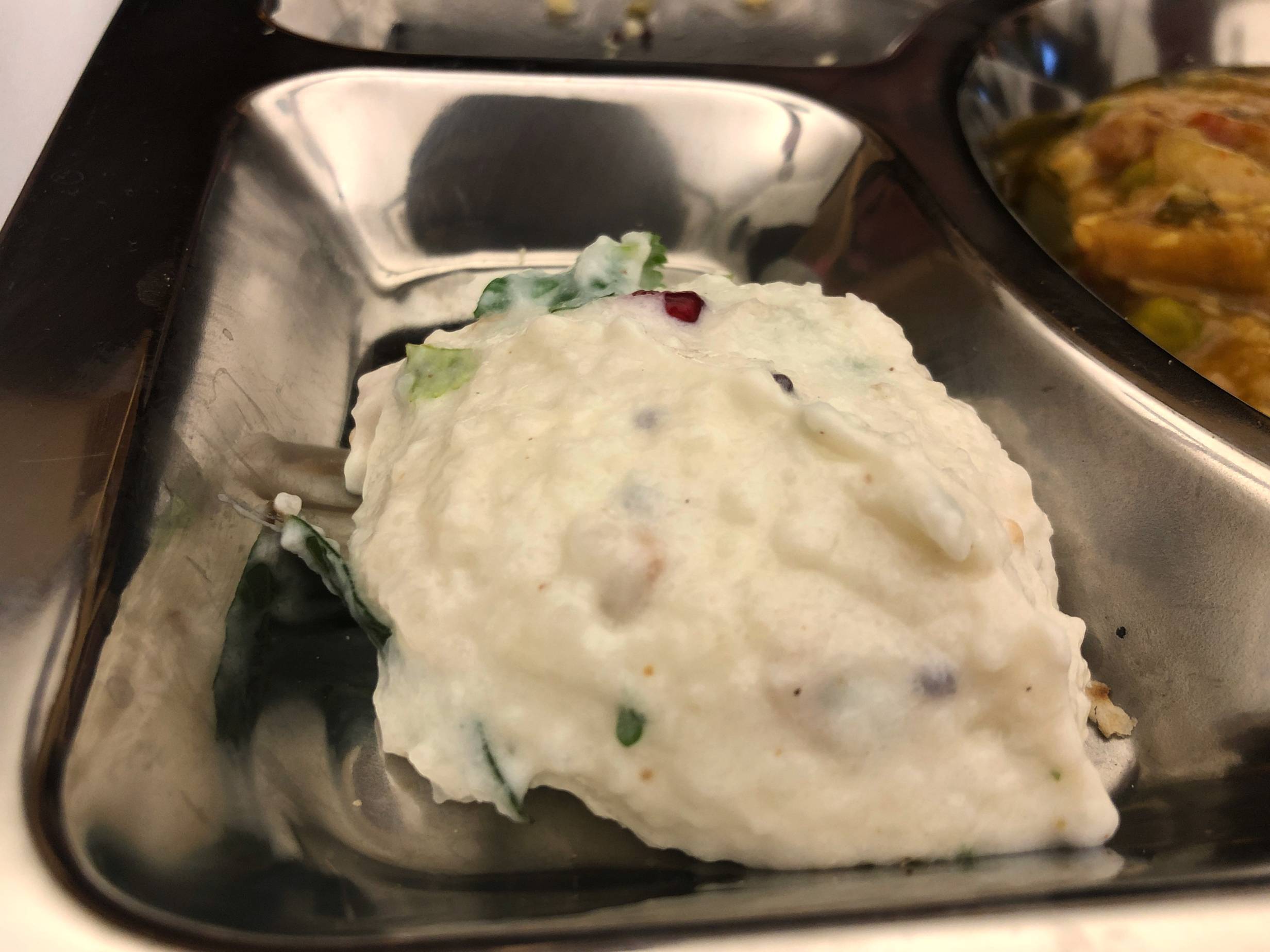
Curd rice. Photo by Alyssa Buckley.
Shekara told us not to mix the two dishes, that the curd rice was meant to cool our system. The curd rice was unlike anything I’d had before. The curd rice was a rice based dish made with cultures from India, tempered with mustard seeds, dal, and curry leaves garnished with pomegranate. It was a cold, thick scoop. If she didn’t tell me that it was a rice dish, I would not have known. The yogurty flavor was the leading flavor, and the pomegranates gave a good crunch and touch of sweetness.
At this point, I was becoming confident eating with my hand. Shekara assured us that licking your fingers was a compliment, and she loved seeing us do that with her food.
The fourth course was Rasam, a tomato and tamarind based soup that came in eclectic ceramic cups.
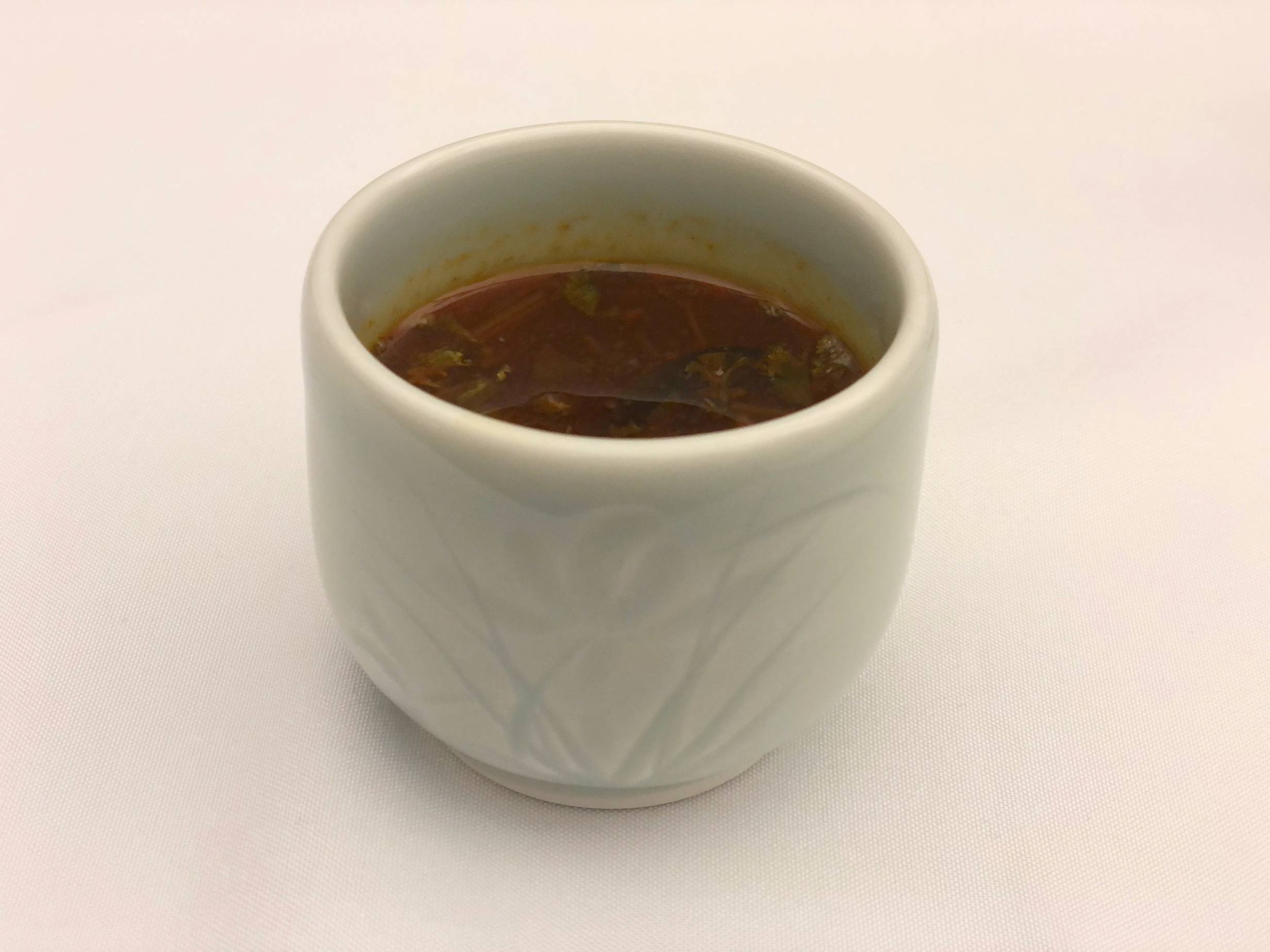
Course 4. Photo by Alyssa Buckley.
The rasam was served warm, not hot in temperature — definitely hot in spice. It was a really intense soup: strong flavors of tomato, turmeric, ginger, and tammerin. The spiciness was near my limit, but I enjoyed sipping the soup.
After this course, we were each provided a small bowl with a lemon wedge.
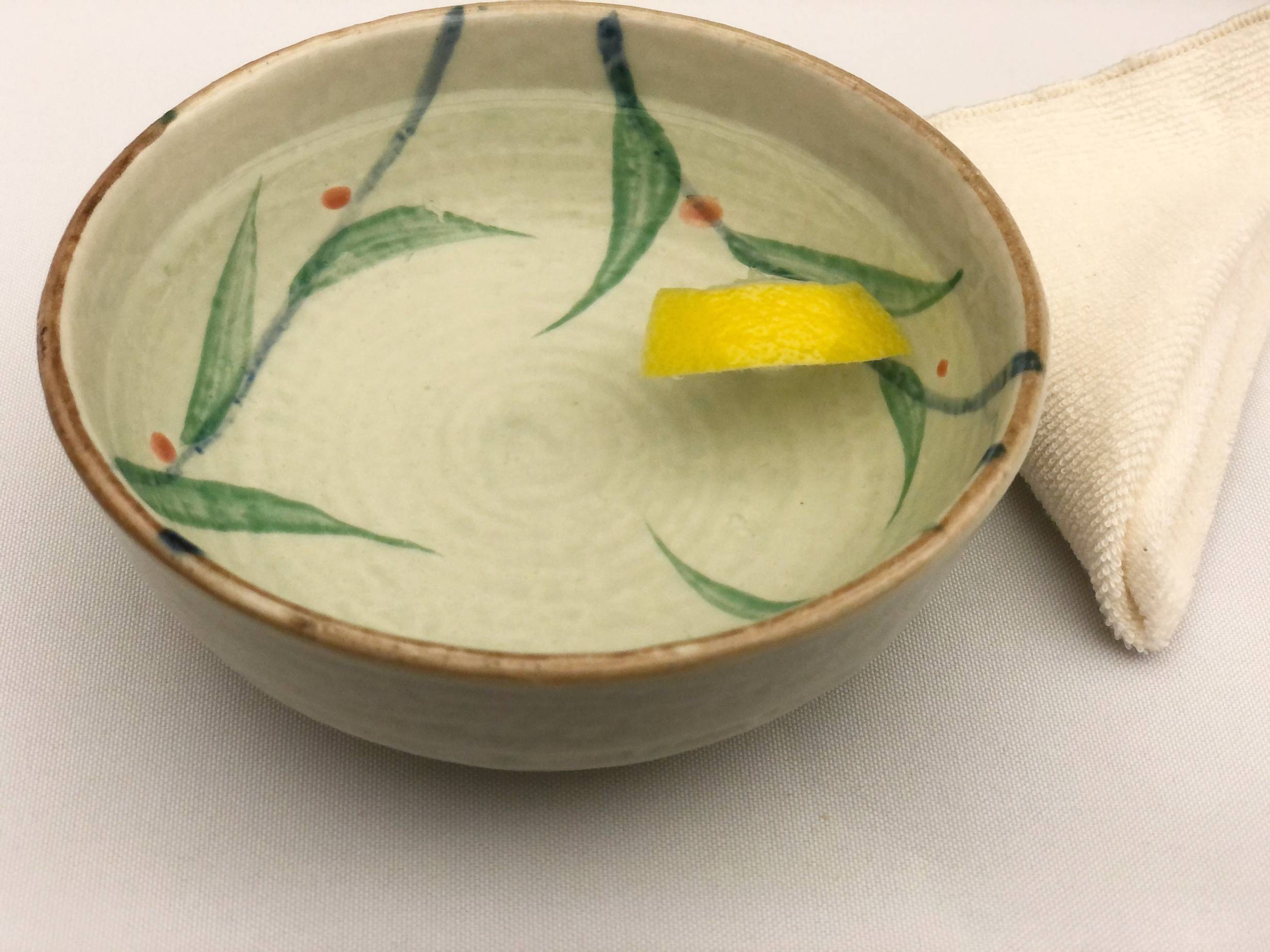
A lemon water bowl. Photo by Alyssa Buckley.
At first, I thought it was another soup, but Shekara asked us to wash our right hand with this bowl. It was cold water, and it was refreshing to clean my fingers after all the courses. I really enjoyed the beauty of this respite.
The fifth course was a fresh fruit course: a trio of grape clusters and mini cantaloupe balls.
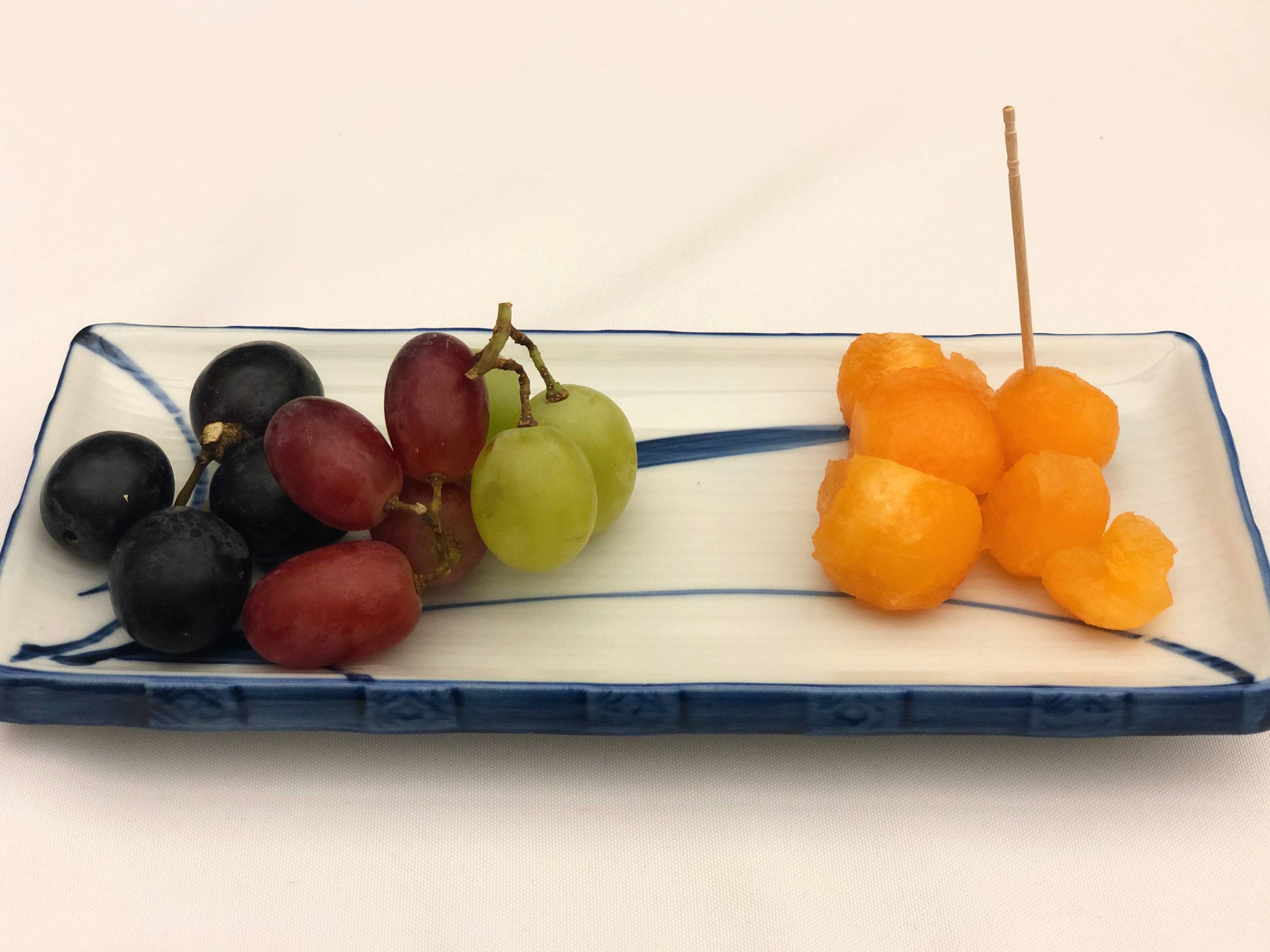
Course 5. Photo by Alyssa Buckley.
I have had grapes before, of course, but I had never had three different kinds at once. It was a delight to try the black grapes, red grapes, and green grapes side-by-side and appreciate the slight differences in taste. The fruit was all deliciously sweet.
The final course was Kaju Paan, a cashewnut fudge with betel leaf and rose petal jam.
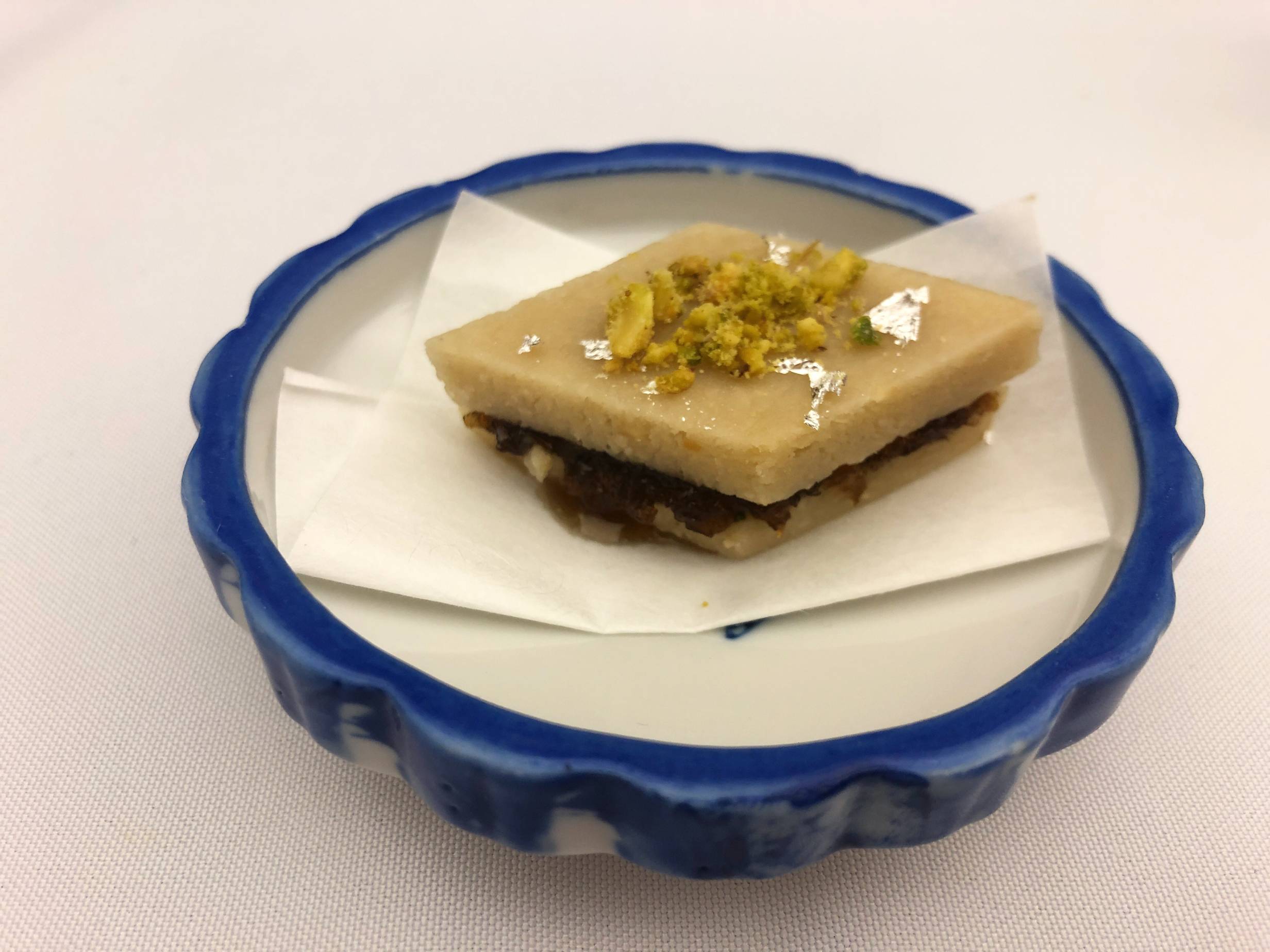
Course 6. Photo by Alyssa Buckley.
It was a beautiful diamond shaped cookie sandwich with crushed pistaccios and edible silver foil on top. The dessert had an assertive rose flavor. Eating the sweet, I had a full sensory experience of smelling the floral and nutty notes, feeling the delicate cashew fudge, and tasting the bouquet of the jam. It was reminiscent of a peanut butter and jelly dessert, but this kaju paan is an elevated, complex cashew treat.
Overall, it was a tranquil dinner experience where I learned so much about Shekara, south India, and how she’s blended her homes in Bloomington-Normal and India into delicious recipes that she shared with us. The Ananda: Indian Home Cooking & Traditions event was a distinctive experience where I enjoyed a truly blissful dinner.
Japan House has a mission to bring about cultural understanding and offer exposure to new perspectives. Absolutely in the scope of this mission, this event brought cultural understanding and an exposure to Indian food and culture in an authentic way.
I would recommend following Japan House for updates about their events. Buy tickets for events early because tickets sell out quickly — and for good reason.
Japan House will host a Wagashi (Japanese Sweet) Workshop on April 21st at 5:30 p.m. Tickets for that event will be released on March 23rd. The Japan House Spring Open House is scheduled for April 4th.
Japan House
2000 S Lincoln Ave
Urbana








